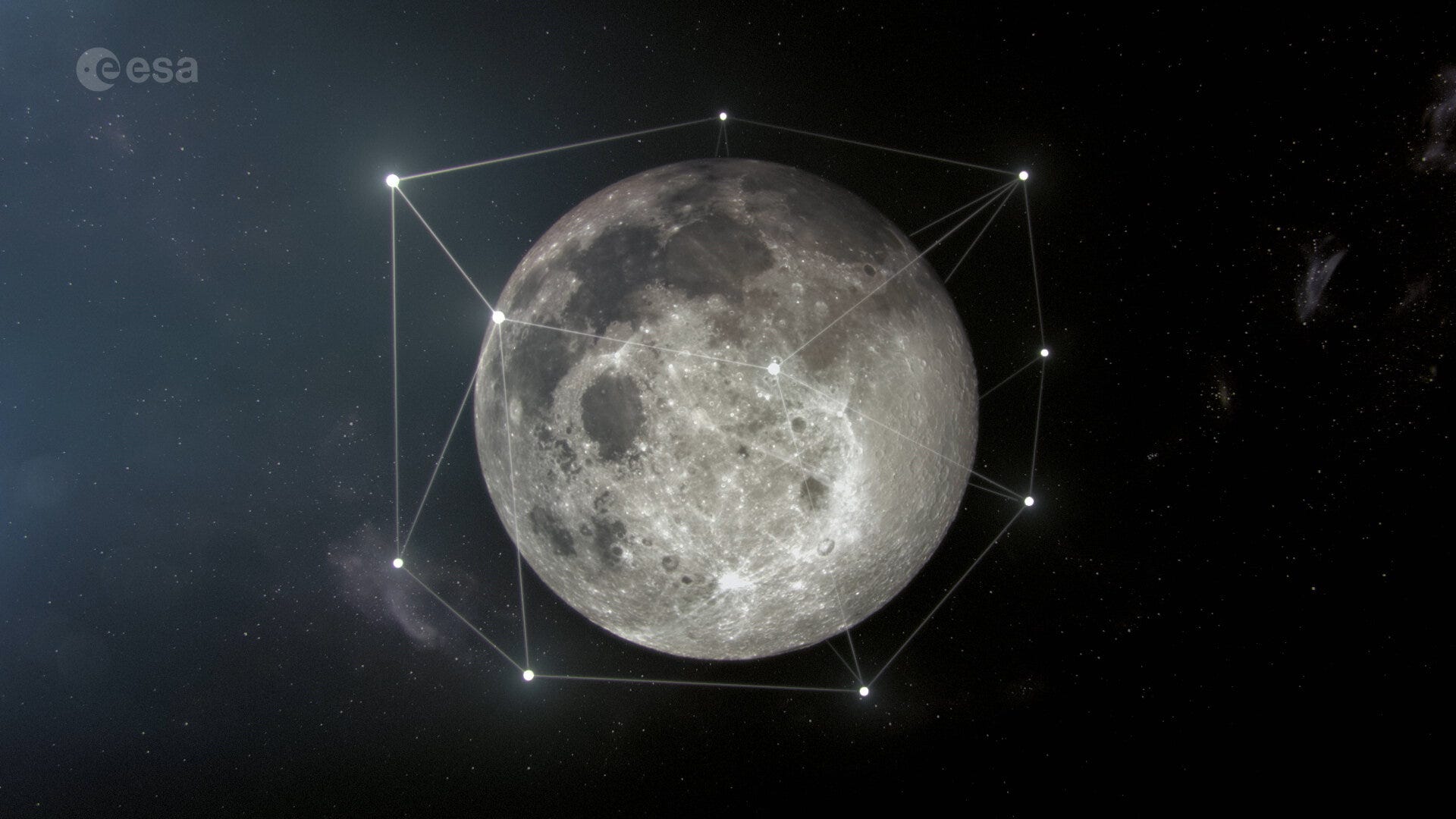Moon Monday Issue #28
ESA progresses on its lunar communication network, Firefly selects SpaceX to launch its Moon landing mission, Orion's successful splash test, what's in the Moon's mantle, and more lunar developments.
Highlight
ESA is funding two consortia of companies for its Moonlight initiative to make detailed plans that would demonstrate the feasibility of a lunar communication and navigation service. Surrey Satellite Technology Limited will lead the first consortium, with Airbus as one of its partners, while Telespazio will lead the second one, with Thales Alenia Space as one of its partners.

A lunar communication and navigation service wouldn’t just enable cost-effective Moon missions that needn’t build their own comms but also enable farside missions, and allow rovers to talk to Earth even when exploring areas that don’t have direct Earth visibility. Such a service could also provide a common time reference for lunar-based fundamental physics and astronomy experiments, including farside radio astronomy.
The awarded contract, the funding amount of which isn’t clear, will last till end of 2022 after which ESA will either select one of the two consortia, or a mix of both, to build Moonlight and be operational by 2028. ESA plans to make Moonlight available commercially, and hopes that smaller nations will participate in lunar exploration thanks to the cost-effectiveness such a service would enable.
Exploration
Firefly has selected SpaceX Falcon 9 to launch its Blue Ghost Moon lander in 2023, a mission to part of NASA’s CLPS program. Blue Ghost will be carrying 10 NASA instruments and separately contracted (undisclosed) commercial payloads to Mare Crisium. Firefly says that the Falcon 9’s high performance allows them to save fuel, and deliver more than 150 kilograms of payload to the Moon’s surface. Interestingly, their press release says that Blue Ghost will operate payloads not just during lunar transit, orbit, and on the surface for a complete lunar day—about 14 Earth days—but also “well into the freezing dark of lunar night.” For SpaceX, this is the fifth out of the six NASA CLPS missions they’re launching, with the exception being Astrobotic’s 1st mission which is launching on ULA’s Vulcan rocket in December this year.
NASA performed the fourth and final water drop test of a mock version of its Orion capsule, the aim of the tests being to verify the capsule’s structural design before NASA sends humans onboard Artemis II. Unlike the other tests where the capsule was dropped straight down from increasing heights, this one was a swing drop from 24 meters high and 41 meters sideways, thus adding a horizontal velocity component to simulate a realistic mission scenario. Orion splashed at 66 kilometers per hour, and turned upside down, which isn’t an issue even if it happens on a real mission. Engineers will now study the data, and tweak the Orion capsule design if required.

ESA has contracted Belgium-based Space Applications Services to develop a set of 3 reactors that produce oxygen from lunar soil as part of an unnamed 2025 ESA mission. Space Applications Services, working with 8 other European companies and research institutes, has refined a special electrolysis process to get pure oxygen at the anode that can then be used as air or propellent, and metal at the cathode, usable later in manufacturing. This ESA contract follows the company’s previous demonstration of a prototype system.
NASA has requested $5.4 billion from the U.S. Congress, as part of a larger national infrastructure bill, for the (Lunar) Human Landing System, specifically to fund competition for Artemis crewed missions beyond the first landing. NASA has also requested $200 million to fund commercially developed spacesuits for the Artemis program. Both the funding amounts, if passed, would be spent over several years in addition to the agency’s budget.
As part of an outreach article, NASA has subtly mentioned that Astrobotic’s contract to deliver the agency’s VIPER rover to the Moon has been increased from the original amount of $199.5 million to approximately $226.5 million. NASA said in March that the mission itself would cost $433.5 million instead of the originally projected $250 million as NASA is enhancing the mission’s science investigation to better map water and other resources in and around permanently shadowed regions near the rover’s landing site at the Moon’s south pole.
South Korea is in last-minute negotiations to sign NASA’s Artemis Accords, per a local news outlet’s report on May 18. NASA has already been collaborating with South Korea for years on the latter’s Korea Pathfinder Lunar Orbiter mission launching in August 2022. In March 2021, NASA tightened the collaboration by selecting nine scientists to join the mission’s science team.
ESA, under the French space agency’s lead, will build a self-sufficient lunar base analogue in France by 2023 to test technology demonstrations, independent operations, and life support systems. This is the third of ESA’s federated network of such initiatives focused on lunar bases, the other two being in Germany and UK.
NASA has awarded a total of $500,000 to 7 winning teams in Phase 1 of the agency's Watts on the Moon Challenge to design future power systems for sustainable human and robotic outposts on the Moon.
Science
Using spectral data from Apollo 15-17 soil samples as reference, and correlating with spectral measurements by the Japanese SELENE orbiter, scientists have mapped the global distribution of minerals on the Moon with an aim to understand what the mantle is made of based on traces of it on the surface. They find that the massive-impact-formed South Pole-Aitken basin and the rocky lunar highlands have more low-calcium pyroxene than olivine, meaning it represents the lower mantle composition. Other mountain rings part of mare areas or those with less severe impacts have more olivine, representing the upper mantle.

By studying the persistent dust cloud around the Moon observed by NASA’s LADEE mission, scientists have made a multi-plume model for the first time that considers all major sources of micrometeorite bombardment. They identify β-meteoroids—really fast moving dust grains on hyperbolic orbits away from the Sun—as an appreciable source. The authors propose a LADEE-like mission in a polar orbit to provide missing observations so that we can fully describe ejecta from micrometeorite bombardment on the Moon. This knowledge would help us estimate the loss and accumulation of water and other volatiles in the Moon’s permanently shadowed regions.
Building on the discovery of water in sunlit regions on the Moon’s surface, scientists now seek to understand how much water released from the lunar soil due to high temperatures seeps back in. They predict that the amount of accumulated subsurface water is as low as several micrograms per unit area, and higher at the poles where peak temperatures are much lower than equatorial or mid-latitude regions.
More Moon
The Planetary Society’s guide to the super blood Moon on May 26.
Neat video by Apogee Space explaining how a Lunar Starship paired with NASA’s Commercial Crew Low Earth Orbit systems is demonstrably better, sustainable, and cost-effective than SLS for the Artemis program.
Thank you Epsilon3 and SWISSAPOLLO for supporting me and powering this edition of Moon Monday.
Everyone, I’m publishing this one-of-a-kind Moon exploration newsletter for free, with no ads. And it will stay that way. If you like my work, support me to keep it going.
